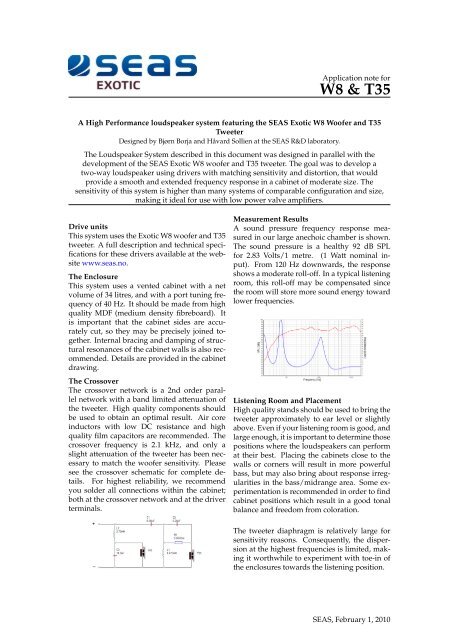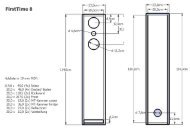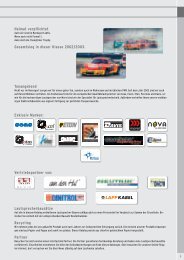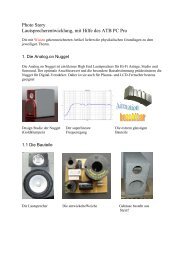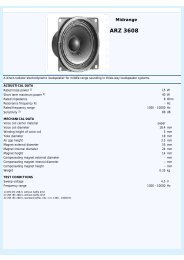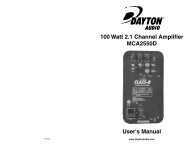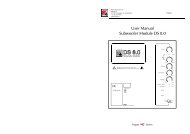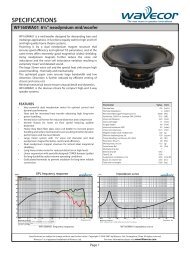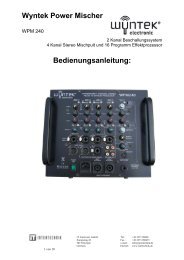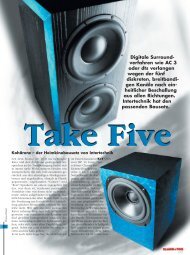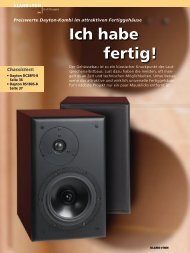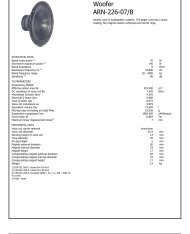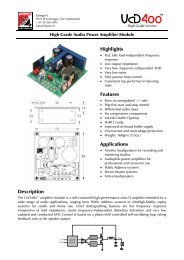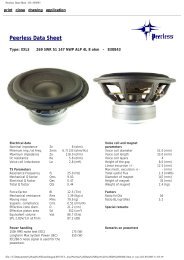Enclosure plan for Seas Exotic W8 & T35 - Madisound
Enclosure plan for Seas Exotic W8 & T35 - Madisound
Enclosure plan for Seas Exotic W8 & T35 - Madisound
Create successful ePaper yourself
Turn your PDF publications into a flip-book with our unique Google optimized e-Paper software.
Application note <strong>for</strong><br />
<strong>W8</strong> & <strong>T35</strong><br />
A High Per<strong>for</strong>mance loudspeaker system featuring the SEAS <strong>Exotic</strong> <strong>W8</strong> Woofer and <strong>T35</strong><br />
Tweeter<br />
Designed by Bjørn Borja and Håvard Sollien at the SEAS R&D laboratory.<br />
The Loudspeaker System described in this document was designed in parallel with the<br />
development of the SEAS <strong>Exotic</strong> <strong>W8</strong> woofer and <strong>T35</strong> tweeter. The goal was to develop a<br />
two-way loudspeaker using drivers with matching sensitivity and distortion, that would<br />
provide a smooth and extended frequency response in a cabinet of moderate size. The<br />
sensitivity of this system is higher than many systems of comparable configuration and size,<br />
making it ideal <strong>for</strong> use with low power valve amplifiers.<br />
Drive units<br />
This system uses the <strong>Exotic</strong> <strong>W8</strong> woofer and <strong>T35</strong><br />
tweeter. A full description and technical specifications<br />
<strong>for</strong> these drivers available at the website<br />
www.seas.no.<br />
The <strong>Enclosure</strong><br />
This system uses a vented cabinet with a net<br />
volume of 34 litres, and with a port tuning frequency<br />
of 40 Hz. It should be made from high<br />
quality MDF (medium density fibreboard). It<br />
is important that the cabinet sides are accurately<br />
cut, so they may be precisely joined together.<br />
Internal bracing and damping of structural<br />
resonances of the cabinet walls is also recommended.<br />
Details are provided in the cabinet<br />
drawing.<br />
The Crossover<br />
The crossover network is a 2nd order parallel<br />
network with a band limited attenuation of<br />
the tweeter. High quality components should<br />
be used to obtain an optimal result. Air core<br />
inductors with low DC resistance and high<br />
quality film capacitors are recommended. The<br />
crossover frequency is 2.1 kHz, and only a<br />
slight attenuation of the tweeter has been necessary<br />
to match the woofer sensitivity. Please<br />
see the crossover schematic <strong>for</strong> complete details.<br />
For highest reliability, we recommend<br />
you solder all connections within the cabinet;<br />
both at the crossover network and at the driver<br />
terminals.<br />
Measurement Results<br />
A sound pressure frequency response measured<br />
in our large anechoic chamber is shown.<br />
The sound pressure is a healthy 92 dB SPL<br />
<strong>for</strong> 2.83 Volts/1 metre. (1 Watt nominal input).<br />
From 120 Hz downwards, the response<br />
shows a moderate roll-off. In a typical listening<br />
room, this roll-off may be compensated since<br />
the room will store more sound energy toward<br />
lower frequencies.<br />
Listening Room and Placement<br />
High quality stands should be used to bring the<br />
tweeter approximately to ear level or slightly<br />
above. Even if your listening room is good, and<br />
large enough, it is important to determine those<br />
positions where the loudspeakers can per<strong>for</strong>m<br />
at their best. Placing the cabinets close to the<br />
walls or corners will result in more powerful<br />
bass, but may also bring about response irregularities<br />
in the bass/midrange area. Some experimentation<br />
is recommended in order to find<br />
cabinet positions which result in a good tonal<br />
balance and freedom from coloration.<br />
The tweeter diaphragm is relatively large <strong>for</strong><br />
sensitivity reasons. Consequently, the dispersion<br />
at the highest frequencies is limited, making<br />
it worthwhile to experiment with toe-in of<br />
the enclosures towards the listening position.<br />
SEAS, February 1, 2010
8<br />
7<br />
6<br />
5<br />
4<br />
3<br />
2<br />
A<br />
F F<br />
E E<br />
D D<br />
C C<br />
3,0<br />
B B<br />
200,0<br />
A<br />
Material: 25mm MDF<br />
Designed by Checked by Approved by Date<br />
A terje 18.09.2008<br />
A<br />
8<br />
7<br />
6<br />
5<br />
4<br />
3<br />
2<br />
Date<br />
K0224<br />
CABINET EXOTIC<br />
Edition Scale<br />
1<br />
1:2<br />
1<br />
R11,0<br />
R11,0<br />
n130,0<br />
6,0<br />
n88,0<br />
n188,0<br />
5,5<br />
550,0<br />
432,0<br />
n221,0<br />
251,5<br />
103,0<br />
94,5<br />
n105,0<br />
n79,0<br />
Ø70,0<br />
inside tube<br />
45,0°<br />
335,0<br />
270,0


